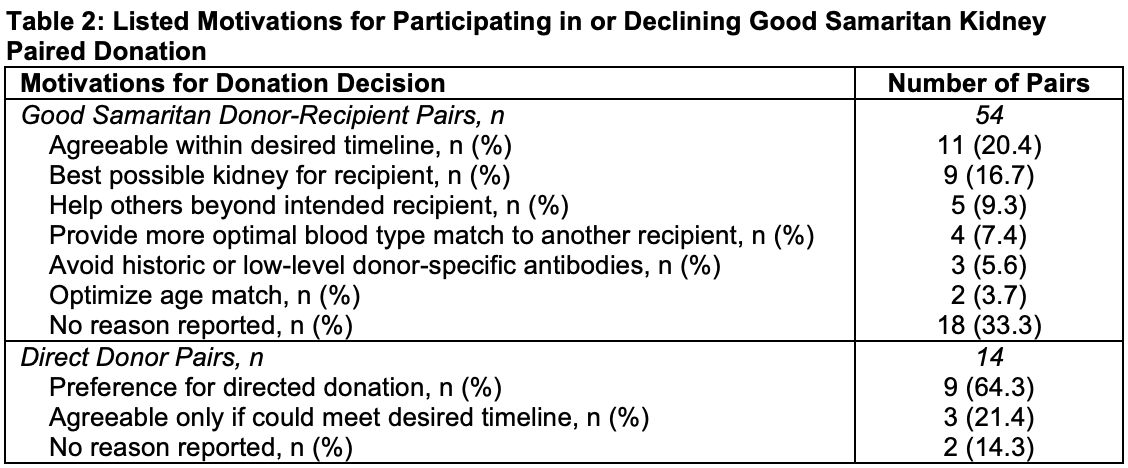Identifying reasons Good Samaritan donors participate in paired kidney donation
Andrea M Meinders1, Adib Edilbi1, Linda W Moore1, Khush Patel1, Hemangshu Podder1, Mark J Hobeika1,2, Richard J Knight1,2, Amy D Waterman1,2, Stephanie G Yi1,2, A. Osama Gaber1,2.
1Surgery, Houston Methodist Hospital, Houston, TX, United States; 2Weill Cornell Medicine, New York, NY, United States
Introduction: Kidney paired donation (KPD) provides non-matching donor-recipient pairs with opportunities to exchange kidneys and participate in living donor kidney transplantation (LDKT). Good Samaritan KPD donors (compatible pairs that volunteer to participate in an exchange instead of donating directly) provide unique opportunities to initiate and extend donation chains; however, the characteristics and motivations of individuals consenting to or declining to participate in Good Samaritan donation are not well described.
Methods: We retrospectively reviewed LDKTs performed at a single center, identifying paired donations involving Good Samaritan KPDs and direct donations where Good Samaritan KPD was thoroughly explained but declined. Donor and recipient demographics, clinical characteristics, and the donors’ and recipients’ motivations for participating in or declining KPD were reviewed.
Results: From 2016-2024, we identified 54 Good Samaritan donor-recipient pairs and 14 direct donation pairs who were approached for Good Samaritan KPD but declined. Good Samaritan donors had a median age of 46.5 years, were most often female (68.5%), had blood type O (77.8%), and were their intended recipient’s spouse (38.9%). Direct donors had a median age of 32 years, were equally male and female, most commonly blood type O (85.8%), and varied in their relationship to the recipient (Table 1). KPD chains created by Good Samaritan pairs had a median length of 3 pairs (range: 1-5). Good Samaritan KPD donors reported willingness to help others if surgery occurred within the desired timeline (20.4%), wanted the intended recipient to receive the best possible graft (16.7%), or wanted to help multiple recipients in the process (9.3%; Table 2). Of those with listed reasons for declining Good Samaritan donation, most of the donor-recipient pairs discussed the opportunity and opted to donate directly (64.3%). Interestingly, 3 (21.4%) pairs were agreeable if surgery was available within their desired timeline; however, KPD was unable to be arranged.
" href="https://app.tts2024.org/papers/body/1088#">

Conclusion: In our experience, Good Samaritan donor-recipient pairs are willing to help multiple recipients receive an LDKT when it can occur within their desired timeline and the matching and longevity of their recipient’s transplant can be strengthened. Further qualitative research is needed to determine why more donors turn down participation in KPD.
Andrea M. Meinders is a Burroughs Wellcome Fund Fellow supported by a Burroughs Wellcome Fund Physician Scientist Institutional Award to the Texas A&M University Academy of Physician Scientists.
[1] Living kidney donor transplantation
[2] Kidney paired donation
